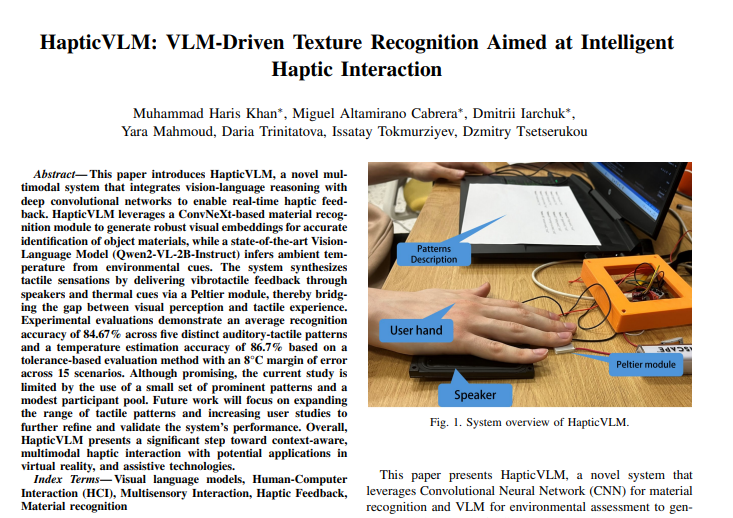Tactile perception, the most primitive and direct way for humans to perceive the world, is experiencing a new burst of vitality driven by technology. While we were still lamenting the lack of realistic touch in virtual reality, a research team from the Skolkovo Institute of Science and Technology in Russia has quietly rewritten this situation. Their latest HapticVLM multimodal tactile system achieved an impressive material recognition accuracy rate of 84.7%, marking a new milestone in the development of human-computer interaction technology.
The significance of this breakthrough goes beyond the numbers themselves. In the past, tactile feedback technology was often limited to simple vibration patterns that could not accurately convey the real feel of different materials. The emergence of the HapticVLM system has completely overturned this situation, allowing machines to gain the ability to perceive material textures similar to humans for the first time.
The technical core of the HapticVLM system lies in its ingenious architectural design. The system cleverly integrates deep convolutional networks with visual language reasoning technology, achieving a seamless transition from visual information to tactile feedback. The entire recognition process flows smoothly: the system first uses an advanced ConvNeXt architecture to perform a deep scan of objects, accurately identifying the cold hardness of metal, the warm and rough texture of wood, or the soft delicacy of fabric. Then, the system generates highly stable visual embedding data, providing a solid data foundation for subsequent material identification.

What's more astonishing is that HapticVLM also possesses the wisdom of environmental perception. By leveraging the latest Qwen2-VL-2B-Instruct visual language model, the system can intelligently infer the temperature conditions of the surrounding environment and seamlessly integrate this information into the tactile experience. This multidimensional perception capability brings the virtual tactile experience one step closer to the real world.
The revolutionary improvement in user experience is reflected in the system's carefully designed dual feedback mechanism. When a user's finger gently touches the surface of a virtual object, the HapticVLM will generate vibration feedback perfectly matched to the specific material through high-precision speakers. These vibrations are not simple mechanical vibrations but complex waveforms calculated precisely, capable of accurately simulating the firmness of a metal surface, the rough texture of wood, or the smoothness of silk fabric. Each touch brings a convincing sense of realism.
The addition of the temperature feedback system elevates the entire experience to a new level. Through an integrated Peltier module, the HapticVLM can provide precise dynamic temperature changes, allowing users to truly feel the coldness of metal, the warmth of wood, or even the warmth radiating from freshly baked bread. This meticulous temperature control, combined with perfect coordination of vibration and auditory elements, creates an unprecedented immersive sensory world.
Experimental data fully verify the outstanding performance of the HapticVLM system. In comprehensive tests covering five different auditory tactile modes, the system achieved an average recognition accuracy of 84.67%, which is considered exceptional among similar technologies. More encouragingly, in 15 complex environmental scenarios, the system demonstrated an impressive accuracy rate of 86.7% in temperature estimation challenges, fully demonstrating its strong capabilities in environmental perception.
Despite these impressive achievements, the research team maintains a scientific and rigorous attitude. They honestly point out the current limitations of the system and clearly define future development directions. The team plans to further expand the breadth and depth of tactile modes while strengthening user experience research, striving to make the technology better serve actual human needs. This spirit of continuous improvement in scientific research suggests that the HapticVLM system still has great potential for development.
The application prospects of the HapticVLM system are extremely broad, covering almost all digital scenarios requiring tactile interaction. In virtual reality games, players will be able to realistically feel the sharpness of a sword blade and the weight of armor. On online shopping platforms, consumers can experience the real feel of products before purchasing. In remote medical care, doctors can perform more accurate remote diagnoses through tactile feedback. In education and training, students can gain a deeper understanding of physics and chemistry knowledge through tactile experiences.
This technological breakthrough is not only a success at the engineering level, but also represents a deep exploration of digital sensory experiences. The launch of the HapticVLM system marks that we are entering a new era of digital interaction, where the boundary between virtual and reality will become increasingly blurred, and human-computer interaction will reach an unprecedented natural and harmonious level.
As technology continues to advance and application scenarios continue to expand, we have every reason to believe that the tactile interaction technology represented by HapticVLM will become one of the infrastructures of the future digital world. The digital future filled with real tactile sensations is coming toward us.
Paper address: https://arxiv.org/pdf/2505.02569
